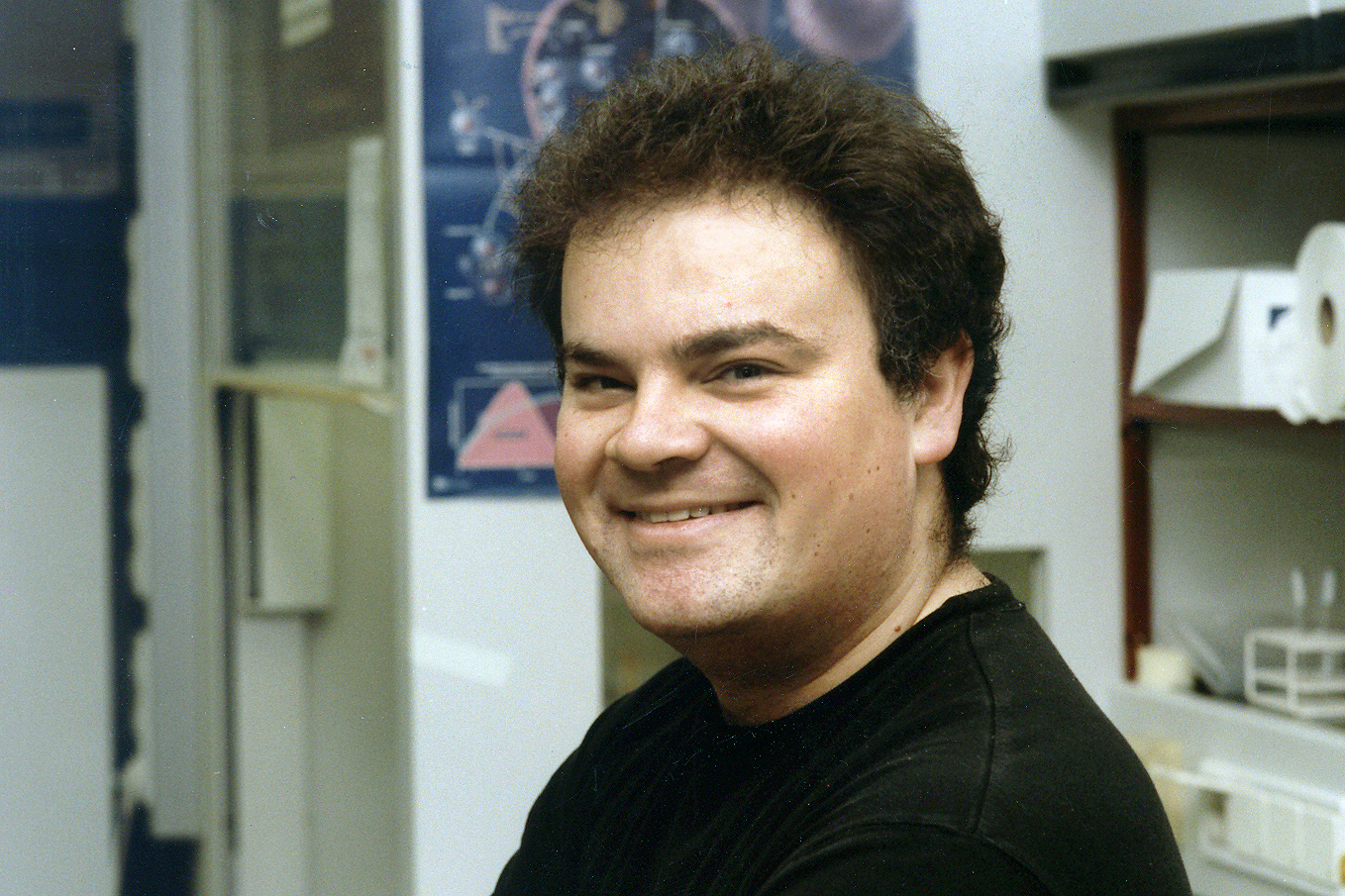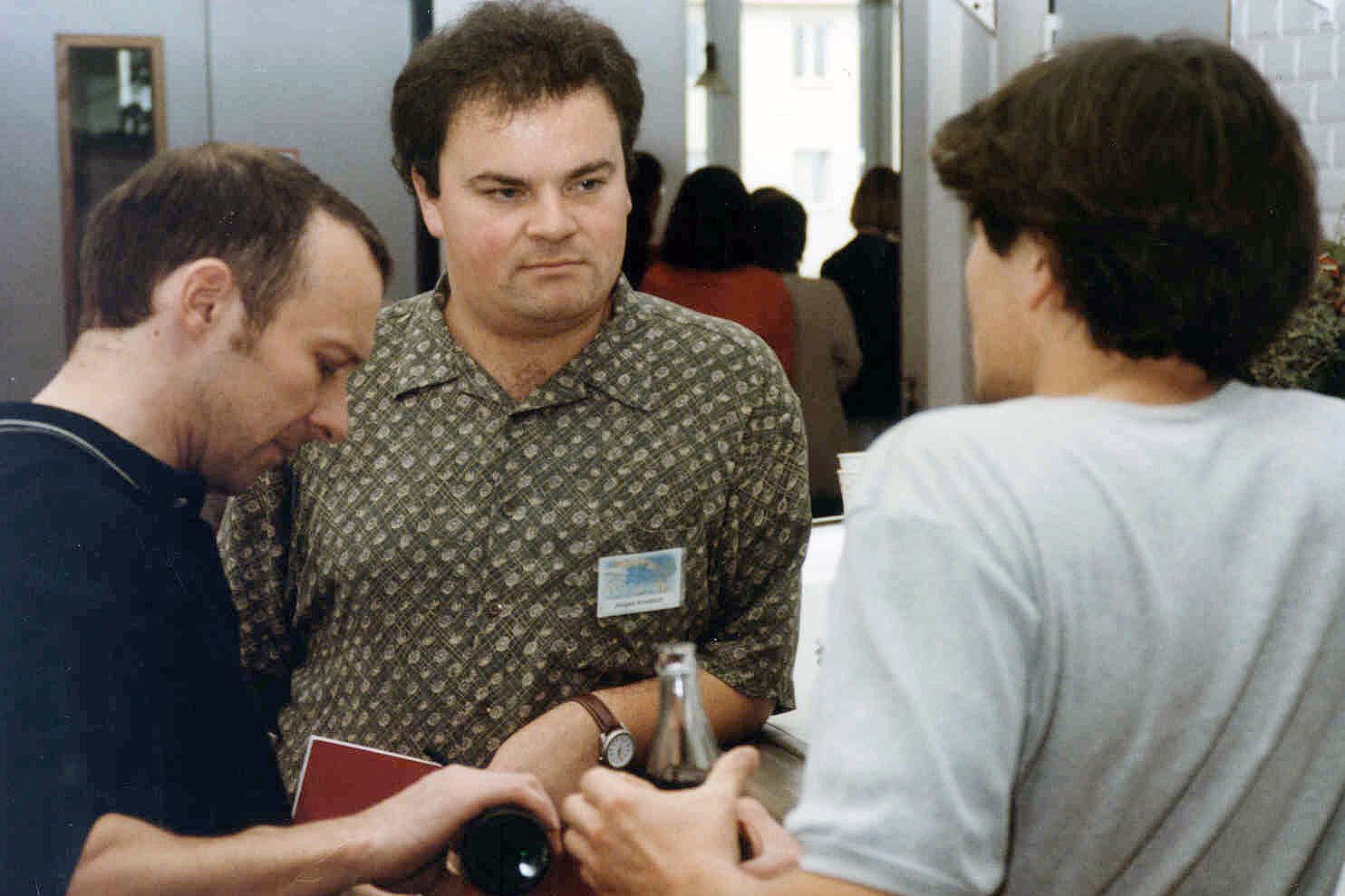Mechanisms of asymmetric cell division
Jürgen Knoblich may be best known for his work on cerebral organoids at IMBA, but his nearly 30-year career in Vienna began at the IMP, where his group deciphered the molecular mechanisms of asymmetric cell division in the developing fruit fly (Drosophila) nervous system. These achievements, which made the textbooks, laid the groundwork for the organoid breakthroughs that became both textbook material and springboard for international fame.

Cell division is fantastically complex, requiring equal distribution of chromosomes, organelles, cytoplasm, and cell membrane to two daughter cells. To make things even more complicated, some cells do not divide symmetrically, instead producing daughter cells destined for vastly different fates. Such asymmetric cell divisions are particularly important in the developing nervous system.
In 1994, the first step towards a molecular understanding of asymmetric cell division was made: the lab of Lily and Yuh Nung Jan at the University of California, San Francisco, discovered that asymmetric cell division in the developing Drosophila nervous system requires a protein known as Numb to segregate to one of the two daughter cells. Jürgen Knoblich, who had worked on cell division during his PhD, joined the lab as a postdoc to study this phenomenon. He found that a protein called Inscuteable localises to the apical side (or top) of the parent cell and is required for Numb localisation to the opposite basal side (or bottom), as well as for correct spindle orientation.
Jürgen wanted to delve further into the molecular machinery of asymmetric cell division as he set about finding a PI position. In 1997, he was invited to interview at the IMP, a relatively new institute at the time. Jürgen was intrigued by the IMP’s connection to Boehringer Ingelheim, but this also gave him pause for thought. “When I received the offer from IMP, I hesitated a lot”, he recalls. “I felt that, if Boehringer Ingelheim loses interest in the IMP, then the Drosophila groups will be the first to go.” Nonetheless, Jürgen accepted the offer, and established Drosophila as a model organism in Austria. He did not regret his decision to join the IMP: “I was very positively surprised by Boehringer Ingelheim’s interest”, he says.
Jürgen set out to find the key drivers of asymmetric cell division using Inscuteable as a molecular entry point. Matthias Schäfer, one of the first PhD students to join the lab, and Markus Schober, a diploma student, focused on Bazooka, another apically-localised protein important for cell polarity. The students first showed that Bazooka physically interacts with Inscuteable. They then used RNA interference, a new technology at the time, to knock down Bazooka expression, which showed that it is essential for Inscuteable’s apical localisation. These findings earned the lab its first paper (Schober et al., Nature 1999).
Mark Petronczki, another diploma student in the lab, then identified Par-6 to be a partner of Bazooka that is also required for Inscuteable’s apical localisation (Petronczki & Knoblich, Nat Cell Biol 2001). This added another component to the complex, which was later dubbed the Par complex. But what happens downstream of Inscuteable to enable asymmetric cell division? To find out, the group took three complementary approaches: biochemical analysis, a yeast two-hybrid system, and a large-scale genetic screen.
Matthias, with a background in biochemistry, purified Inscuteable from fly embryos and identified its binding partners using mass spectrometry. This approach revealed Partner of Inscuteable (Pins) and a heterotrimeric G-protein α subunit (Schaefer et al., Curr Biol 2000). The asymmetric localisation of Pins required both Inscuteable and Bazooka, suggesting it was one of the downstream components the group had been looking for. The researchers were forced to publish quickly, as another group had also identified Pins and were due to publish in Cell. In a subsequent paper, Jürgen’s group expanded on their findings, showing that Pins activates a heterotrimeric G-protein signalling cascade at the apical side of the cell, and that this may be a broadly conserved strategy for establishing asymmetry (Schaefer et al., Cell 2001). This paper also introduced a new paradigm for G protein activation – without the canonical extracellular ligands and transmembrane receptors.

For the second approach, Elke Kleiner, a technician in the lab, performed two-hybrid screening to identify Inscuteable-binding proteins. Such an approach can pick up interactions that are too transient to detect using biochemistry. Silvia Bulgheresi, Jürgen’s first PhD student, set about characterising the candidate interactors and described a microtubule-binding protein that localises apically (in an Inscuteable-dependent manner), clustering in a thick crescent shape. They decided to call the protein Cornetto (Italian for croissant). However, Cornetto’s exact function proved difficult to decipher – Silvia managed to knock out the corresponding gene but observed no phenotype (Bulgheresi et al., J Cell Sci 2001).
Finally, the lab’s third PhD student, Daniela Berdnik, and first postdoc, Tibor Török, used a genetic approach to search for candidates involved in Numb localisation. Barry Dickson, who joined the IMP as a group leader soon after Jürgen, shared his cutting-edge suite of Drosophila research tools. “This was very generous of Barry and made it possible to do a large-scale genetic screen”, Jürgen says. The screen revealed α-Adaptin, a protein involved in receptor-mediated endocytosis (Berdnik et al., Dev Cell 2002), and mitotic kinase Aurora-A (Berdnik and Knoblich, Curr Biol 2002). Both would be the subject of important work by the Knoblich group extending beyond Jürgen’s time at the IMP.
When Jörg Betschinger joined the lab as a PhD student in 2002, Matthias Schäfer had already completed his PhD. Jörg followed in Matthias’s biochemical footsteps, and by determining proteins that interacted with Par-6, he identified the cytoskeletal protein Lgl (Betschinger et al., Nature 2003). Jörg showed that the Par complex phosphorylates and inactivates Lgl, preventing cell fate determinants from localising to the apical side of the cell, and thus restricting them to the basal side. Jörg, together with Andrea Hutterer, who joined the lab as a diploma student and later as a PhD student, added further details to this mechanism, suggesting that polarity is maintained via mutual inhibition between the Par complex and the active Lgl protein (which excludes Par-6 from the basal side) (Hutterer et al., Dev Cell 2004). This concept of antagonistic interactions provided a powerful framework for understanding cell polarisation.
In short, over the course of seven successful years, Jürgen’s team achieved what he had set out to do when joining the IMP. “We found one piece after another of this asymmetric cell division machinery”, he summarises. Since their conceptual understanding of the process in Drosophila was quite advanced, the group started to study similar processes in vertebrate neural stem cells.
Yet, by then, Jürgen’s time at the IMP had come to an end and he began planning his next career move. He had a contract from another institute on his desk waiting to be signed when he was approached with a last-minute opportunity to stay in Vienna. Josef Penninger, founding director of IMBA, a new institute initiated by the Austrian Academy of Sciences and Boehringer Ingelheim, asked Jürgen if he would join.
The rest, as they say, is history: Jürgen has been at IMBA ever since, serving as deputy director from 2005 and interim director from 2018 to 2024. Continued collaborations with Barry Dickson made Vienna a global hotspot for Drosophila genetics and cell biology, while Jürgen’s later work catalysed Vienna’s emergence as a global leader in organoid research. The latter would not have been possible without the earlier achievements at the IMP: “The Drosophila work inspired the kind of analyses we did”, Jürgen says, referring to his group’s groundbreaking work modelling microcephaly in brain organoids and establishing the link between defective asymmetric cell division and reduced brain size. His group also showed how defective asymmetric cell division can lead to brain tumour formation.
Jürgen’s time at the IMP proved formative for his subsequent career. “It was a family”, he says, “with all the advantages and disadvantages of a family”. Regular reunions bring former members of the Knoblich group – many now successful PIs themselves – together again. And while Jürgen’s scientific path has taken him away from fruit flies, he has not forgotten the lessons he learned. “Now, we’re trying to apply the principles of Drosophila genetics to the human brain”, he says.
First published in 2025.
References
Bazooka recruits Inscuteable to orient asymmetric cell divisions in Drosophila neuroblasts.
Schober M, Schaefer M, Knoblich JA; Nature 1999
DmPAR-6 directs epithelial polarity and asymmetric cell division of neuroblasts in Drosophila.
Petronczki M, Knoblich JA; Nat Cell Biol 2001
A protein complex containing Inscuteable and the Galpha-binding protein Pins orients asymmetric cell divisions in Drosophila.
Schaefer M, Shevchenko A, Shevchenko A, Knoblich JA;Curr Biol 2000
Heterotrimeric G proteins direct two modes of asymmetric cell division in the Drosophila nervous system.
Schaefer M, Petronczki M, Dorner D, Forte M, Knoblich JA; Cell 2001
Inscuteable-dependent apical localization of the microtubule-binding protein Cornetto suggests a role in asymmetric cell division.
Bulgheresi S, Kleiner E, Knoblich JA; J Cell Sci 2001
The endocytic protein alpha-Adaptin is required for numb-mediated asymmetric cell division in Drosophila.
Berdnik D, Török T, González-Gaitán M, Knoblich JA; Dev Cell 2002
Drosophila Aurora-A is required for centrosome maturation and actin-dependent asymmetric protein localization during mitosis.
Berdnik D, Knoblich JA; Curr Biol 2002
The Par complex directs asymmetric cell division by phosphorylating the cytoskeletal protein Lgl.
Betschinger J, Mechtler K, Knoblich JA; Nature 2003
Sequential roles of Cdc42, Par-6, aPKC, and Lgl in the establishment of epithelial polarity during Drosophila embryogenesis.
Hutterer A, Betschinger J, Petronczki M, Knoblich JA; Dev Cell 2004